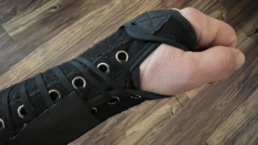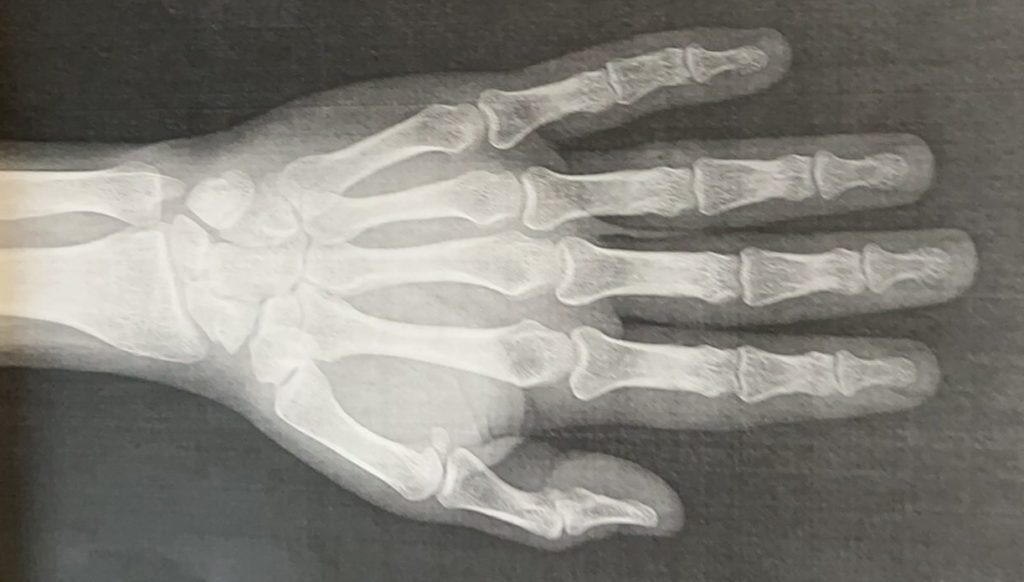Restarting practice after an injury
A hand injury can be an existential crisis for a guitar player.
I had the misfortune of slipping on the ice on Christmas Eve, landing by my outstretched left hand. (Vocabulary word of the day: ER doctors call that a Foosh, Fall On Out Stretched Hand).
It could have been a lot worse. I sustained two small fractures in the bones at the base of my index finger. Treatment has consisted of wearing a brace, and basically laying off my guitar.
It’s important that I offer this disclaimer now. I am not a doctor, and I have no medical training:
If you suffer an injury yourself, follow your medical professionals’ advice.
This piece is about what to do once you’ve been given the all clear to start playing again. Warming up is always important, but even more so after a period away from the guitar. When I asked my doctor about it, his advice was to let pain be the guide.
Patient: hey doc, it hurts when I do this.
Doctor: so don’t do that!
If you’re still young and indestructible, you might not think any of this applies to you. But remember, guitar playing is athletic for the hands. Athletes who don’t train properly hurt themselves. More positively, this mindset builds the kind of fluid control every guitarist is aiming for.
If you haven’t played in a while, your muscle memory is still there, but we need directed control too. Without control, muscle memory movements are like a twitch: nothing but impulse to move. Tuning in to sensation and touch creates a more complete mental picture of what your hands are doing, beyond just where the finger sits. That complete mental picture is what leads to real control.
Let’s take a moment to look at an x-ray of the hand:
Notice how the bones of the fingers and thumb extend all the way back to the base of the hand.
So your fingers don’t end at the knuckle but continue back to the bones of wrist. When palm is relaxed, the whole system is more open and the fingers move more freely. Similarly, your thumb extends all the way to the base of the wrist.
It’s very easy to miss this point, but it’s crucial. If your thumb is pressing on the back of the neck, that pressure compresses the center of the hand. Try this without a guitar and you’ll find it MUCH harder to move the fingers freely when the thumb is pushing down. Since many if not most students apply much pressure with the fret hand thumb, it’s possible your muscle memory could use the reset.
Returning to your guitar with this gentle tuning in to the sensation of touch is also a great opportunity to reprogram bad technical habits.
Just remember to start off easy. Don’t play a song, or a scale. Touch one note. Pay attention to the pressure on the fingertip, letting it rest on the string rather pushing it down. This is a good way to warm up under any circumstances, because you’re not just warming up the muscles. You’re also making a tactile, brain-to-finger connection.
Try this as a visualization exercise:
When the the hand is relaxed, the fingers should naturally curl. Imagine the bones of the fingers running up through the hand, and try to feel the space between them. Relax the base of the thumb and allow the palm to open. Imagine the hand broadening, giving all your fingers more room.
Move your hand to the guitar, maintaining this feeling. Use your arm to bring the hand into position. Keep the base of the thumb relaxed and notice how it naturally allows the fingers to move more freely.
My own practicing lately has consisted of very light and gentle hand movements to start with, working to open chords, and then beginning to work in gentle stretches. The entire time, I am keeping the mental picture of that hand x-ray in my mind. I want to maintain the sense of openness and space between the fingers, and let my arm do the work instead of my hand and wrist. This is, ultimately, the way you always want to warm up, but it’s especially important when you’re rebuilding.
In the long run, this kind of practicing will make you a better player and less susceptible to repetitive strain.
Also remember that when it comes to playing an instrument, “no pain no gain” is NEVER the right mindset. Your body will tell you when it’s being overtaxed, as long as you learn how to listen to it.
Interested in more guitar lessons and courses? Check out JamPlay.com. JamPlay has over 450 guitar courses from 120+ instructors, and online guitar lessons tailored to every skill level, music genre, and playing style. Click here to learn more.
Dave Isaacs has established himself as a guitar teacher extraordinaire, having built a strong set of educational curriculums for beginner, intermediate, and advanced guitar players alike. Dave shares his expertise largely through video platforms, but also through his thoughtful writing. You can take guitar lessons from Dave Isaacs via his comprehensive video guitar courses on JamPlay.com.
Share this
Become a JamPlay member for unlimited access to 7000+ guitar lessons and 120+ artists and instructors. View membership plans ›






